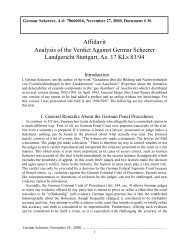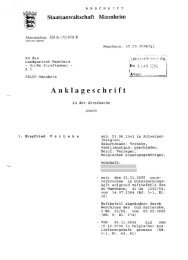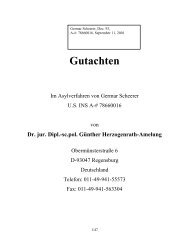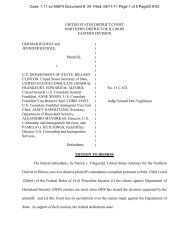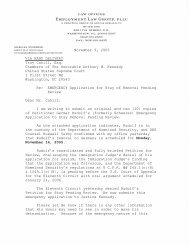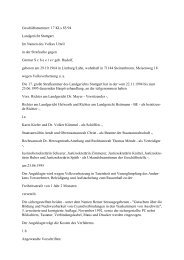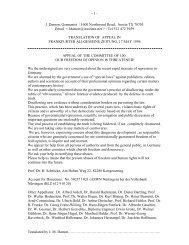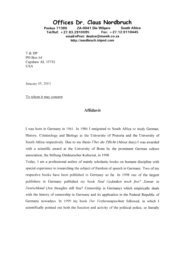Germar Rudolf, Resistance Is Obligatory (2012; PDF-Datei
Germar Rudolf, Resistance Is Obligatory (2012; PDF-Datei
Germar Rudolf, Resistance Is Obligatory (2012; PDF-Datei
Create successful ePaper yourself
Turn your PDF publications into a flip-book with our unique Google optimized e-Paper software.
GERMAR RUDOLF, RESISTANCE IS OBLIGATORY<br />
5 Otto D. Kulka, “Die deusche Geschichtsschreibung über den Nationalsozialismus und die<br />
‘Endlösung.’ Tendenzen und Entwicklungen 1924-1984,” in: Historische Zeitschrift, vol. 240<br />
(1985), pp. 599-640, esp. pp. 617ff.<br />
6 Inflated numbers can be coerced, as it was indeed the case with Höss. (Kommandant in Auschwitz.<br />
Autobiographische Aufzeichnungen des <strong>Rudolf</strong> Höss. Ed. by Martin Broszat, Munich (dtv)<br />
1963, pp. 149, 167.) Already from this results the necessity of scientific revisions with regard to<br />
the widespread opinion about Auschwitz. In the book Streitpunkten (Berlin-Frankfurt 1993) I<br />
stated: “Such an assertion cannot be invented, but it can all too easily be exaggerated” (p. 310).<br />
7 Cf. “Historikerstreit.” Die Dokumentation der Kontroverse um die Einzigartigkeit der nationalsozialistischen<br />
Judenvernichtung, Munich 1987. My article “Vergangenheit, die nicht<br />
vergehen will” (“A past that refuses to pass,” Frankfurter Allgemeine Zeitung of June 6, 1986)<br />
can be found on pp. 39-47.<br />
8 I give only a single example from the most recent past for the lacking disposition of this school<br />
to reproduce trains of thought without gross distortions or to grant their opponents sincere motives:<br />
In my interview with the [newsmagazine] Spiegel of 3 October 1994 (no. 40, pp. 83-103)<br />
I stated that the fact that the adjective “humane” was used both by other National Socialists as<br />
well as primarily by Hitler with regard to the “punishment” of the Jews convinces me more<br />
than anything else of the reality of the gas chambers. The subsequent question typical of the<br />
Spiegel was whether I really considered it more humane to be gassed in a Nazi concentration<br />
camp rather than starved to death. I rejected this objection and stated that this is evidently a<br />
perversion of the term “humane.” That did not prevent one of the authors of the anthology Antisemitismus<br />
in Deutschland edited by Wolfgang Benz to carry this underhanded insinuation further<br />
still by claiming that I had described the gas chambers as a “humane killing method.”<br />
(Daniel Gerson, “Der Jude als Bolschewist. Die Wiederbelebung eines Stereotyps,” in: Antisemitismus<br />
in Deutschland. Zur Aktualität eines Vorurteils, Munich (dtv) 1995, pp. 157-180, p.<br />
176).<br />
9 It is a curious fact that a compilation of important witness accounts has been prepared only by<br />
the revisionist side: Jürgen Graf, Auschwitz. Tätergeständnisse und Augenzeugen des Holocaust,<br />
Würenlos (Switzerland) 1994. The same author has also written with utter conviction and<br />
moral indignation the popular presentation: Der Holocaust-Schwindel. Vom Werden und<br />
Vergehen des Jahrhundertbetrugs, Basel 1993. If one takes the Deutsche Manifest as a comparison,<br />
which was anonymously published on 8 May 1995, then it becomes apparent that different<br />
levels have to be distinguished within revisionism as well: the inflamatory, the populist and<br />
a third, which presumably has to be called “scientific.”<br />
10 Peter Longerich (ed.), Die Ermordung der europäischen Juden. Eine umfassende Dokumentation<br />
des Holocaust 1941-1945, Munich-Zurich 1989, p. 69.<br />
11 Wolfgang Benz, Antisemitismus in Deutschland (see note 8), p. 135; Artur Brauner et al.,<br />
“Wider das Vergessen, denn wie sollte man vergessen,” in: Frankfurter Allgemeine Zeitung,<br />
May 6, 1995.<br />
12 Eberhard Jäckel, Jürgen Rohwer, Der Mord an den Juden im Zweiten Weltkrieg. Entschlußbildung<br />
und Verwirklichung, Stuttgart 1985, p. 12.<br />
13 Ibidem, p. 147.<br />
14 Ibidem, p. 190.<br />
15 Ibidem, p. 170.<br />
16 Ibidem, p. 187.<br />
17 This sentence by this reputable U.S.-Jewish historian, which by now has been quoted frequently<br />
by revisionists, stems from his book Der Krieg als Kreuzzug. Das Deutsche Reich, Hitlers<br />
Wehrmacht und die “Endlösung,” Reinbek 1989, p. 362, which is unique within the entire scientific<br />
literature about the final solution due to its lack of source references. See my review in<br />
the Jahrbuch Extremismus & Demokratie, 2nd vol. 1990, pp. 335-339.<br />
18 New York 1989, p. 475.<br />
19 Jean-Claude Pressac, Die Krematorien von Auschwitz. Die Technik des Massenmordes, Munich-Zurich<br />
1994, p. 202. In the original French edition of 1993, p. 148, slightly higher figures<br />
were given (630,000 and 775,000, respectively).<br />
20 London-Nairobi, 1985.<br />
21 Cf. Benz (note 8), p. 130.<br />
22 Bernd Naumann, Auschwitz, Berichte über die Strafsache gegen Mulka und andere vor dem<br />
Schwurgericht Frankfurt, Bonn 1965, pp. 511, 530f.<br />
284




